The Pink City
- By Katharine
- 27 February, 2014
- 5 Comments
Jaipur is a bazaar for the senses: a cacophony of horns, the bleat of goats, and the singing of the muezzin from the minaret of a nearby mosque; bright saris and scarves, polished gems and semi-precious stones, hand-printed fabric, and women aswirl with color; the scents of incense and cow dung, spices and urine, flowers and diesel; the feel of silk, cashmere, and pashmina wool; and flavors of a million different curries – some hot and complex, some dry, some cinnamon-sweet, and some rich and buttery.
But Jaipur’s most remarkable feature is the old city, where the facades of all the buildings were painted terra cotta and ornamented in white in preparation for a visit from Prince Albert, who christened Jaipur “The Pink City.” The old city is surrounded by a wall with massive gates, and the buildings represent a merger of Hindu and Muslim architectural styles, with many gorgeous arches and onion domes. The most beautiful building is the Hawa Mahal, or Palace of the Winds, which features several stories of screened balconies, from behind which the royal women used to watch processions and festivals.
We took a VERY early train from Delhi yesterday morning, leaving the hotel at 4:50 a.m. The four-hour train ride took us through lush, green countryside, where the main crops are wheat and mustard greens. It was a relief to see green and open spaces after the crowds of Delhi. Our hotel caters entirely to foreign tourists and features a lovely garden and café, terraces and courtyards, and excellent food. We all collapsed for a bit, reconvened for lunch, and then went on a tour by taxi to a workshop that demonstrated a local method of hand-printing fabric. Next stop was a jewelry store, where we watched a man polish a moonstone on a spinning disc covered with diamond dust, which he powered with a rigid leather strap he pushed back and forth, like a bow over the strings of a violin. Several men served us cups of fragrant chai as we browsed – and bought.
Just as we got back to the hotel, a hailstorm started, followed by heavy rain and a thunderstorm that cleaned the air. We ate dinner at a restaurant with a courtyard. We sat like pashas in a sort of covered alcove to one side, while young women in glittering costumes with full skirts performed traditional dances and twirled with pots of fire on their heads. A trio of musicians accompanied them.
Today we rode a public bus to the Amber Fort, a hilltop fastness surrounded by about 19 km of walls climbing up and down the surrounding slopes and protected by another purely military fort on an adjoining hill. Of all the forts and palaces we’ve seen, this was by far the most spectacular, in part because its Hindu rulers maintained excellent diplomatic relations with the invading Mughals, so it was never looted as the forts in Delhi were. As we walked up switchback ramps to the top, we started passing painted elephants carrying tourists. Symbols of Ganesh – the elephant god, who is thought to bring good luck – are everywhere inside. Elephant heads and trunks form the corners of the arches in one area of the palace, while a colorful painting of Ganesh is the centerpiece over one of the interior gates.
We climbed ever higher, led by a knowledgeable guide who showed us the summer and winter palaces. The winter palace is made of white marble, intricately decorated with thousands of tiny mirrors (from Belgium) that twinkled at night like stars, reflecting light from the oil lamps. The palace walls and ceilings are also inlaid with colored Murino glass (from Italy). It was hard to comprehend the massive wealth that built all this. Finally we arrived in the oldest and highest part of the castle, where the ruler’s 12 wives had their individual apartments: three on each side of a square courtyard. The king’s apartments are up above in one corner and connected to a narrow passage that runs all the way around the inner wall, with a narrow staircase descending into each of the 12 apartments. That way, he could visit each of his wives discreetly, without arousing the jealousy of the others.
We enjoyed drinks and snacks in a coffee shop near the top of the palace, then rode a bus back into the center of Jaipur. Our tour leader had us get off near an excellent restaurant, but first we went shopping, haggling with vendors who all beckoned us to sit down on comfy, padded benches while they displayed their scarves, tunic tops, and Punjabi suits (also known as a salwaar kameez). Four of us – Kate, Nina (both English), Rosanna (Brazilian, but living in London) and I stuck together, doing lots of haggling and a bit of buying before meeting three young couples in our group for lunch. The restaurant served an enormous Rajasthan thali – a huge metal plate with 10 little dishes artfully arranged around the center, containing different curries, sweets, dahl, and seasoned yogurt, along with two kinds of bread, rice, papadums, and some kind of filled dumpling that you’re supposed to break open and drizzle curry over. Two of our party ordered those, while some of the others ordered more Western food. One man’s order of garlic toast came garnished with potato chips. I ate cucumber raita and seasoned rice, as my stomach’s a bit dodgy from all the rich and spicy food.
After lunch, I gathered a crowd while trying to buy a few hand-polished beads – then the four of us crowded into a tuk-tuk meant for three and bounced along behind buses, scooters, cars, and rickshaws to one of the city gates. Just the other side, pigs and goats rooted through garbage among dozens of parked motorcycles. We climbed another switch-back ramp up through Monkey Valley to a temple to the Sun god. Lots of monkeys, including whole families, caught our eyes and our cameras. One peeled a banana, another picked up and licked a half-eaten popsicle, and yet another turned on a tap outside the temple and drank from it. The sun was really hot, and once we’d reached the top we decided not to climb down the other side to the monkey temple, as it would have meant yet another long climb uphill afterward.
Most of the group went tonight to watch a Bollywood film in Hindi, no subtitles, at a famous and palatial older theater, but I’ve had enough stimulation for one day. Tomorrow we travel to a small village and stay in a former palace, converted to a hotel.
Note: Several of you have told me you’re not getting e-mail notices when I post. Sorry about that – but keep checking back. I’ll try to get a post and pictures up every 2-3 days, but most of the wireless connections here are really slow, so I’m not going to try to fix the e-mail problem.
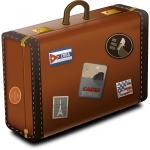
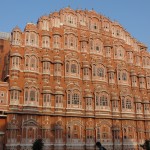
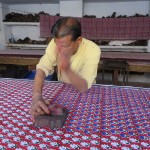
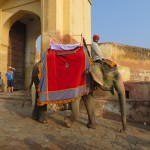
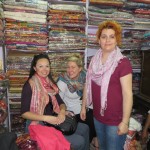
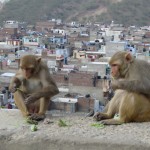
 Copyright © 2024
Copyright © 2024
I’ve just had a wonderful time catching up with all your posts as, like others, I didn’t receive notifications of them. It’s great to read about your experiences as they bring back many memories. Continue to enjoy your time and stay well.
In love with the Palace of the winds!.
Great photos and descriptions, K.
jane
Sounds as though you are having a wonderful time. I really enjoy your blog.
Love, Mom
Katharine, I’m marveling at your wonderful posts and photos, which are so rich in detail and so artfully composed. Are you taking notes as you go? Writing from memory? Tapping away late at night or early in the morning? It’s a treat to do my armchair traveling with such a good reporter.
Glad to know that everything went well and that you’re having a wonderful time! It’s interesting for me as a person of Indian ethnicity to read your perspective on all the experiences you’re having. I’m enjoying reading your detailed posts. They bring back a lot of memories.